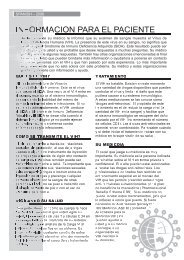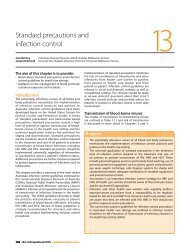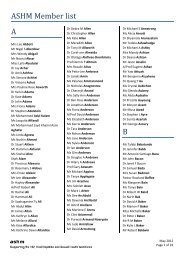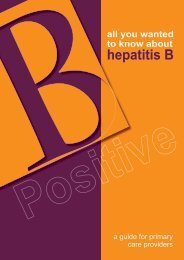HIV, HBV, HCV and STIs: similarities and differences - ASHM
HIV, HBV, HCV and STIs: similarities and differences - ASHM
HIV, HBV, HCV and STIs: similarities and differences - ASHM
Create successful ePaper yourself
Turn your PDF publications into a flip-book with our unique Google optimized e-Paper software.
1 <strong>HIV</strong>, <strong>HBV</strong>, <strong>HCV</strong> <strong>and</strong> <strong>STIs</strong>: <strong>similarities</strong> <strong>and</strong> <strong>differences</strong><br />
cell count falls below 350 cells/mm3, with some<br />
suggesting intervention around 350 cells/mm3, or<br />
when the <strong>HIV</strong> viral load is above 55,000 copies/mL.<br />
Individualised decisions should take into account<br />
the patient’s readiness to start therapy, the baseline<br />
CD4 cell count <strong>and</strong> <strong>HIV</strong> RNA level <strong>and</strong> the potential<br />
risks <strong>and</strong> benefits of treatment. Combination<br />
antiretroviral therapy is very potent in reducing viral<br />
load <strong>and</strong> delaying drug resistance, <strong>and</strong> has resulted<br />
in a dramatic reduction in mortality <strong>and</strong> increased life<br />
expectancy in people with <strong>HIV</strong> infection. This success<br />
has meant that <strong>HIV</strong> infection is becoming a chronic<br />
manageable disease for many people in many<br />
industrialised countries. Immune-based therapies,<br />
such as interleukin-2 <strong>and</strong> therapeutic vaccination, are<br />
also under investigation.<br />
The aim of therapy for <strong>HIV</strong> infection is to sustain<br />
an undetectable viral load, which is achievable in<br />
approximately 50–60% of patients, <strong>and</strong> to produce<br />
immune reconstitution. Immunological benefit may<br />
be modest (CD4 cell counts frequently remain below<br />
normal levels) but may still occur in those who fail to<br />
achieve full virological suppression.<br />
At present we do not know the long-term durability of<br />
the response in those who achieve virological control<br />
or whether drug resistance <strong>and</strong> loss of efficacy will<br />
ultimately emerge. Many of the antiretroviral drugs<br />
have significant side effects <strong>and</strong> some have complex<br />
dosing schedules, making adherence (a major<br />
determinant of the development of resistance) an<br />
issue for concern. However, fixed dose combination<br />
drugs are now available <strong>and</strong> most of the newer<br />
antiretroviral agents are administered once or twice<br />
daily, making adherence to combination regimens<br />
easier. Long-term survival of these people also<br />
has unmasked chronic drug toxicities, particularly<br />
metabolic problems such as lipodystrophy <strong>and</strong><br />
lipoatrophy, hyperlipidaemia, insulin resistance <strong>and</strong><br />
hepatic mitochondrial toxicity. 37<br />
<strong>HBV</strong><br />
The goal of <strong>HBV</strong> treatment is to prevent the<br />
development of hepatocellular failure <strong>and</strong><br />
hepatocellular carcinoma (HCC). This is achieved<br />
through suppression of viral replication with<br />
resolution of hepatic inflammation, as viral eradication<br />
with loss of HBsAg is rare. Treatment is usually<br />
initiated in people with elevated <strong>HBV</strong> DNA >104-5 IU/<br />
mL <strong>and</strong>/or evidence of hepatitis with raised alanine<br />
aminotransferase (ALT) or fibrosis or inflammation on<br />
liver biopsy. Response to treatment can be assessed<br />
biochemically (ALT), virologically (<strong>HBV</strong> serology <strong>and</strong><br />
DNA) or histologically (liver fibrosis). Currently, a<br />
number of different agents are available, including<br />
immunomodulators (interferon-a <strong>and</strong> pegylated<br />
(PEG) interferon-a) <strong>and</strong> antiviral nucleos(t)ide<br />
analogues (lamivudine, adefovir <strong>and</strong> entecavir).<br />
In HBeAg-positive people, the aim of treatment is<br />
HBeAg seroconversion which is associated with a<br />
durable suppression of <strong>HBV</strong> DNA off treatment in<br />
50–90% of people. Treatment with interferon-a is<br />
24 <strong>HIV</strong>, viral hepatitis <strong>and</strong> <strong>STIs</strong>: a guide for primary care<br />
a four to six months finite course associated with<br />
HBeAg seroconversion rates of around 20%, with<br />
higher rates (30%) using the longer acting pegylated<br />
interferon-a. As interferon is an immunomodulator,<br />
it is not associated with viral resistance. It does have<br />
significant systemic side effects, however, which often<br />
means that patients prefer the oral nucleos(t)ide<br />
analogues.<br />
Lamivudine was the first nucleoside analogue<br />
found to effectively reduce <strong>HBV</strong> DNA, with HBeAg<br />
seroconversion rates of 17–32%, usually in those<br />
with raised ALT. However, at four years, over 60%<br />
develop viral resistance to lamivudine. Recently,<br />
entecavir was licensed for first-line <strong>HBV</strong> treatment.<br />
This agent appears to be more effective than<br />
lamivudine, with 67% undetectable <strong>HBV</strong> DNA <strong>and</strong><br />
21% HBeAg seroconversion at 48 weeks. 38,39 <strong>HBV</strong><br />
resistance has been estimated to be approximately<br />
3% by three years, but is significantly higher in those<br />
with previous lamivudine resistance. As a secondline<br />
agent, adefovir is a nucleotide analogue that<br />
effectively suppresses <strong>HBV</strong> DNA but is also associated<br />
with resistance rates of 15% at four years. There is also<br />
the risk of nephrotoxicity <strong>and</strong> hypophosphataemia,<br />
which requires monitoring. The treatment of HBeAgnegative<br />
infection is problematic <strong>and</strong> therapy is<br />
probably needed lifelong to achieve viral suppression.<br />
Newer agents such as tenofovir <strong>and</strong> telbivudine will<br />
become available in the near future. Combination<br />
therapy may offer a future strategy for some patients<br />
if studies demonstrate this to be effective. 29,37,40<br />
Finally, development of end-stage liver disease may<br />
m<strong>and</strong>ate liver transplantation, the outcomes of which<br />
have been significantly improved with the use of<br />
these antiviral therapies <strong>and</strong> <strong>HBV</strong> immunoglobulin to<br />
prevent graft re-infection. 41,42<br />
<strong>HCV</strong><br />
Similar to <strong>HBV</strong>, <strong>HCV</strong> is treated to prevent the<br />
development of cirrhosis, which is associated with<br />
hepatocellular failure <strong>and</strong> hepatocellular cancer.<br />
However, unlike <strong>HBV</strong>, the aim of treatment is viral<br />
eradication. The combination of pegylated interferona<br />
<strong>and</strong> ribavirin is now the st<strong>and</strong>ard of care for chronic<br />
<strong>HCV</strong>. Pegylated interferon is produced through<br />
the attachment of a polyethylene glycol (PEG)<br />
molecule to st<strong>and</strong>ard interferon. This improves the<br />
pharmacokinetic properties of interferon <strong>and</strong> allows<br />
for once-weekly administration. Not only is this new<br />
formulation more convenient to administer but<br />
response rates are enhanced. Sustained virological<br />
remission (SVR) is defined as the absence of <strong>HCV</strong> RNA<br />
from serum six months after completion of therapy<br />
<strong>and</strong> is influenced by both <strong>HCV</strong> genotype <strong>and</strong> <strong>HCV</strong><br />
viral load. SVRs with st<strong>and</strong>ard interferon <strong>and</strong> ribavirin<br />
combination therapy were in the region of 35% for<br />
genotype 1 <strong>and</strong> 80% for genotype 2 <strong>and</strong> 3.<br />
With pegylated interferon there is a significant<br />
improvement in genotype 1 response rates by<br />
approximately 10% to between 42% <strong>and</strong> 52%. 35-45 The<br />
anticipated SVR rate for genotype 2 <strong>and</strong> 3 patients






